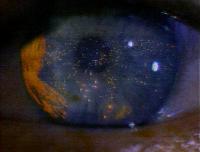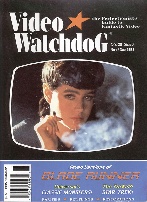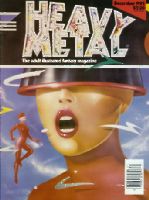Paul M. Sammon Interview
| What is BR? |
| News & Views |
| The FAQ |
| Encyclopedia |
| Quotes |
| People |
| Locations |
| Scripts |
| Analysis |
| Fan-tastic |
| BR Fun |
| BR Game |
| BR Magazine |
| BR Comic |
| Downloads |
| Collectibles |
| Related |
| Links |
| Site Info |
| Search Site |
BRmovie.com is the Home of Blade Runner - the current Blade Runner FAQ, news, resources, links, quotes, scripts and everything else Blade Runner.

![]()
Blade Runner
Buy this Mini Poster at AllPosters.com
|
Any
Comments?
Please e-mail the Webmaster |
| Want the DVD? Or the BR Game? Don't know which books or music to get? Maybe you'd like a Deckard action figure? Make sure you check the BR Related section for all your BR choices. |
|
PS: The flaming eye, as you call it, was a late addition to the film. It was also relatively cheap and easy to do. Relatively. The other proposed openings were either discarded because Ridley felt they wouldn't work in the context of the film, or because they were going to be too expensive to put together. Usually the latter (laughs). N: Similarly, there were a number of endings proposed in different script versions as well. Ignoring the tacked-on drive in the countryside that was added to the Original Theatrical Version, how would you describe the process of deciding how to end the film? PS: Well, at the time, Ridley was known for constantly changing his mind. So there were indeed a number of different endings bandied about. One was going to show Deckard and Rachael in a land car being chased by Gaff in a Spinner, while Deckard realized he was a replicant. Another was going to show Rachael and Deckard fleeing the city through this denuded forest, while Deckard spots a unicorn galloping through the trees. But the climax Ridley finally settled on was the shot of Deckard going into his apartment's elevator after realizing, through the finding of Gaff's tinfoil unicorn, that Deckard was a replicant himself. Then the elevator doors were going to close behind Deckard as he stepped in next to Rachael. BOOM! - end of picture.
N: We only know of some of the things that did not make it into the movie because of your book. You were there on the set of Blade Runner and yet you only started writing Future Noir in 1993. That is a very long gap! You mentioned earlier how the book came about, but why such a long time before it happened?
Really, though, there were three primary reasons I finally wrote Future Noir. One was because I felt there was a terrific story about the making of this film that hadn't been told yet. Two, I wanted to let the average person know what happens - what really happens - during the making of a film. I also thought that doing a book on the making of BR might be a sound career move. And it was, thank goodness. N: DADoES is a Science Fiction book (although I might sub-categorise it as "Proto-Cyberpunk"). However, when Fancher's early Dangerous Days script was doing the rounds, it was simply a Sci-Fi movie. One of the terms we now use to refer to Blade Runner is "Future Noir" - the name of your book. Where did that term come from - is it your invention? And at what point did the film turn from being general Science Fiction into Future Noir? PS: Well, first off, thanks for letting me know that fans are calling BR a "future noir." I didn't know that, and it's very flattering. Anyway, I originally thought that the term "Future Noir" perfectly encapsulated BR's dystopian vision. It was also a phrase that had been rattling around in my head for a long, long time, so I felt it an appropriate title for my book; basically, I thought I'd invented the term. But when I started putting FN's bibliography together, I had to rethink that opinion. Because I then came across the phrase "Future Noir" in a review that'd been published during the film's original release! That confused everything. So now I'm not sure. I could have made the term up while the movie was being shot, which is what memory tells me, or I could have read those words somewhere else back in 1982, and then promptly forgotten about it. Anyway, to be honest, I don't really know where the phrase came from. Either way, I think it's as terrific title for that particular book. I give a lot of thought to my titles, you know; they're very important to me. And I try to be different, and slightly poetic, when I come up with one. For instance - around the time BR was originally released, I had a short story published in the old Twilight Zone Magazine, which was titled "In Late December, Before the Storm". That should give you another indication of where I'm coming from, title-wise. But Future Noir's certainly one of my favorite ones.
|

 N:
The opening scene of Blade Runner - the Hades landscape,
the Eye, the music - is so strong, it is impossible to imagine how
the film could start any other way. And yet a few different beginnings
were proposed, such as Deckard killing a Rep out in the country,
Deckard coming in to L.A. alone on a train, Roy and company waking
up on an Off-World dump, etc. How did those lose out in favour of
the flaming eye we all know and love?
N:
The opening scene of Blade Runner - the Hades landscape,
the Eye, the music - is so strong, it is impossible to imagine how
the film could start any other way. And yet a few different beginnings
were proposed, such as Deckard killing a Rep out in the country,
Deckard coming in to L.A. alone on a train, Roy and company waking
up on an Off-World dump, etc. How did those lose out in favour of
the flaming eye we all know and love? That
was the ending Ridley finally decided on. Until he was forced to
tack on that faux happy ending with its majestic landscapes. Which,
as I'm sure we all know by now, were outtakes from The Shining.
That
was the ending Ridley finally decided on. Until he was forced to
tack on that faux happy ending with its majestic landscapes. Which,
as I'm sure we all know by now, were outtakes from The Shining. PS:
In one way or another, from 1980 onward, I never actually stopped
writing about BR. I kept doing an article about it here and
there - mostly in long-defunct local publications - and I was constantly
being asked and interviewed about the film before I did my book.
I also wrote that BR cover story for Video Watchdog
in 1993. So it's not quite accurate to think that the book simply
sprang into existence 14 years after the film was released.
PS:
In one way or another, from 1980 onward, I never actually stopped
writing about BR. I kept doing an article about it here and
there - mostly in long-defunct local publications - and I was constantly
being asked and interviewed about the film before I did my book.
I also wrote that BR cover story for Video Watchdog
in 1993. So it's not quite accurate to think that the book simply
sprang into existence 14 years after the film was released. As
for BR's metamorphosis from straight sci-fi to future noir,
well, that was a fairly linear process. Hampton had originally written
a character/mood piece in his first draft, with this small-scale
story whose main concerns were ecological (all of Earth's animals
were essentially extinct), romantic (the love story between Deckard
and Rachael), and philosophical (what does it mean to be human)?
Hampton's first screenplay was also dialogue-driven. But once Ridley
signed on, he overlaid Fancher's story with this extravagantly elaborate
production design that had been heavily influenced by the graphic
art in Heavy Metal, a magazine that was dabbling in cyberpunk
long before that term was ever coined. The genius of Ridley's design
overlay, of course, was that it wasn't just a random, disconnected
series of impressive images. Most of that imagery had a point, and
a history, and was somehow connected to BR's story. Or its
themes or the culture of the imaginary Los Angeles Scott had created
for the film. That's one of the reasons I love Blade Runner,
by the way - it's not only gorgeous eye candy, it's eye candy with
a point.
As
for BR's metamorphosis from straight sci-fi to future noir,
well, that was a fairly linear process. Hampton had originally written
a character/mood piece in his first draft, with this small-scale
story whose main concerns were ecological (all of Earth's animals
were essentially extinct), romantic (the love story between Deckard
and Rachael), and philosophical (what does it mean to be human)?
Hampton's first screenplay was also dialogue-driven. But once Ridley
signed on, he overlaid Fancher's story with this extravagantly elaborate
production design that had been heavily influenced by the graphic
art in Heavy Metal, a magazine that was dabbling in cyberpunk
long before that term was ever coined. The genius of Ridley's design
overlay, of course, was that it wasn't just a random, disconnected
series of impressive images. Most of that imagery had a point, and
a history, and was somehow connected to BR's story. Or its
themes or the culture of the imaginary Los Angeles Scott had created
for the film. That's one of the reasons I love Blade Runner,
by the way - it's not only gorgeous eye candy, it's eye candy with
a point.